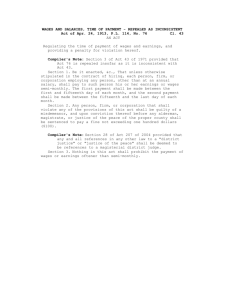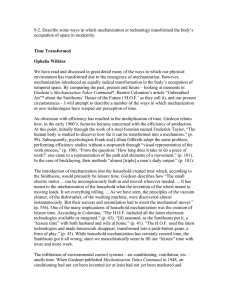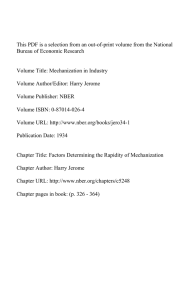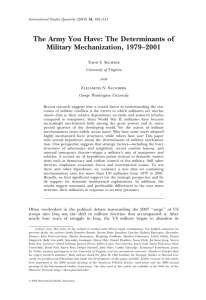Comparing Japanese and Indian Industrialization
advertisement
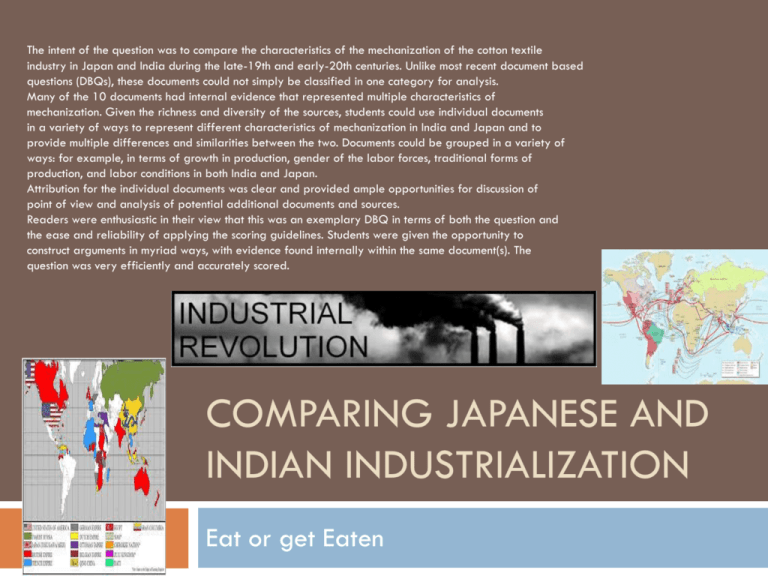
The intent of the question was to compare the characteristics of the mechanization of the cotton textile industry in Japan and India during the late-19th and early-20th centuries. Unlike most recent document based questions (DBQs), these documents could not simply be classified in one category for analysis. Many of the 10 documents had internal evidence that represented multiple characteristics of mechanization. Given the richness and diversity of the sources, students could use individual documents in a variety of ways to represent different characteristics of mechanization in India and Japan and to provide multiple differences and similarities between the two. Documents could be grouped in a variety of ways: for example, in terms of growth in production, gender of the labor forces, traditional forms of production, and labor conditions in both India and Japan. Attribution for the individual documents was clear and provided ample opportunities for discussion of point of view and analysis of potential additional documents and sources. Readers were enthusiastic in their view that this was an exemplary DBQ in terms of both the question and the ease and reliability of applying the scoring guidelines. Students were given the opportunity to construct arguments in myriad ways, with evidence found internally within the same document(s). The question was very efficiently and accurately scored. COMPARING JAPANESE AND INDIAN INDUSTRIALIZATION Eat or get Eaten Historical context Both India and Japan were far behind the industrial technology of the “West” Both India and Japan had been traditionally far ahead in the past India was geographically and culturally heterogenous while Japan was culturally homogenous Japan was unified under the Tokugawa while India had been fragmented under later Mughal Japan had been somewhat isolated before being “opened up” by the United State’s Matthew Perry while India had trading posts (coastal enclaves) for centuries. The Mejii restoration was an attempt by the Japanese governemt to modernize politically (diet) economically (Zaibatsu) and culturall ( adoption of militarism, imperialism and industrialism) while the British East India Company forbade India from benfitting from British industry creating laws and establishing local collaborators and military to enforce India’s dependence on Great Britain Grouping the Docs Groupings must coherently address the characteristics of the mechanization of the cotton industry. Examples of such groupings include: o The growth of mechanization o Dominance of female labor in Japan o Dominance of male labor in India o A comparison of male and female labor between India and Japan o Peasant labor in Japan o Peasant labor in both India and Japan o Rural–urban migrations o Ex–handloom weavers in India o Differences between sources of labor (handloom versus peasant) o Harsh conditions of labor o Low wages o Beneficial and negative consequences of mechanization Why is it important to know that the data was gathered by British colonial authorities? POV: Purpose? Audience? Who would the Japanese Imperial bureau of statistics report to and why? Is ths political reform as a result of the Mejii restoration? These women are recalling events which happened a long time ago. Might there reflections be inexact? Still looks at exploits of female labor ( why female in Japan and not India?) Reforms? A very positive view of a Buddhist monk ( who probably provided most aid in rural Japan) of the girls who were helping with money earned through factory work even identifying the salvation of the girls contributions Clearly an industrialist who supports low wages as a means for keeping people on farms and surplus workers a means to subsidize their families.What might happen if he raises industrial wages according to his argument? This Indian economist is reporting about the benefits of British industrialism in India as ameans to promote local Indian factories, banks, financiers and investors. While Great Britian did help some local collaborators, it might be helpful to hear from the exploited workers on the cotton plantations who lost their subsistence agriculture to grow cotton for Great Britain ( it is estamated that over 3 million died because of this). This was someone’s PHD paper ( dissertation) illustrating the gender difference in Industrial Labor in Japan and India, What might be the reasons for this? What effects might it have had? What is the purpose and audience? Look at the source. It is taken form a Zaibatsu who wishes to illustrate the gainful employment of women ( any abuses here?) How might this compare to Indian labor in industrial factories? The purpose of the British royal commision on labor was to identify the low wages but also the fact that many had been formerly unemployed and that it might be helpful for the British government to keep wages low why? Is there any social Darwinist notions here ( ethnic superiority)? Iron Law of Wages ( keep wages low to keep populations low) This picture comes from a report on Indian mills from an official of a union in India to illustrate men in the factory ( where are the women in comparison to Japan?) Does this work look abusive? How might their low wages impact their work? What documents could you pair this with and why?



